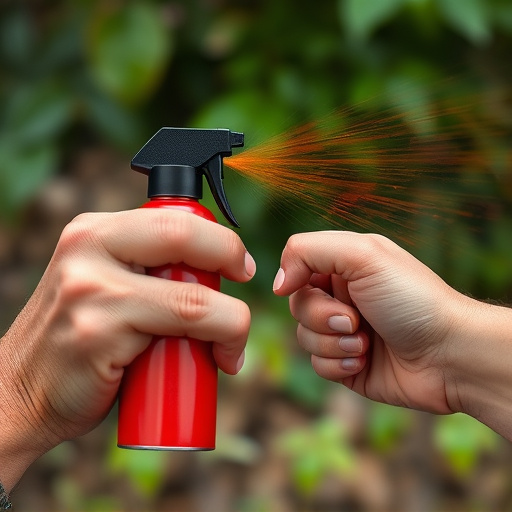The effectiveness of pepper spray depends on its active ingredient, capsaicin, with legal strengths varying by region. The strongest legal pepper spray ingredients, like OC (oleoresin capsicum) or CS gas, cause temporary blindness and respiratory distress in attackers. When choosing a handheld unit, look for specific concentrations (e.g., "1% capsaicin") to ensure potency. Deployment techniques, including aiming for the face or eyes, are crucial for optimal effectiveness while adhering to local laws governing pepper spray usage.
“Uncover the power of self-defense with a handheld pepper spray unit—a compact yet potent tool designed to deter aggressors. In this comprehensive guide, we explore the science behind pepper spray’s effectiveness and how it acts as a legal deterrent. Learn to decipher label claims to identify the strongest legal ingredients, ensuring you’re prepared for any situation. From selection tips to usage guidelines, discover everything you need to know about choosing the right handheld defense unit, empowering you with the knowledge to stay safe.”
- Understanding Pepper Spray: The Science Behind Its Effectiveness
- Decoding Label Claims: Identifying the Strongest Legal Ingredients
- Choosing the Right Handheld Defense Unit for Your Needs
- Usage and Safety Guidelines: Ensuring Effective Protection
Understanding Pepper Spray: The Science Behind Its Effectiveness
Pepper spray, a powerful self-defense tool, has gained widespread popularity for its effectiveness in neutralizing attackers. The active ingredient in pepper spray is capsaicin, a chemical compound found in chili peppers. When deployed, it irritates the eyes and respiratory system, causing temporary blindness, coughing, and difficulty breathing. The strongest legal pepper spray ingredients typically contain high concentrations of capsaicin, often enhanced by other additives to increase its potency and longevity.
The science behind pepper spray’s effectiveness lies in its ability to disrupt normal cellular function. Capsaicin binds to specific receptors in the eyes and nose, triggering a chain reaction that leads to inflammation and pain. This disruption can disable an attacker long enough for the user to escape or gain help. Various factors influence the spray’s performance, including wind speed and direction, distance from the target, and the concentration of capsaicin, ensuring users have a reliable tool for self-defense in different scenarios.
Decoding Label Claims: Identifying the Strongest Legal Ingredients
When shopping for a handheld pepper spray defense unit, understanding label claims is crucial to ensuring its effectiveness. The strongest legal pepper spray ingredients are those that contain high concentrations of capsaicin, often advertised as OC (oleoresin capsicum) or CS gas. These active ingredients are derived from chili peppers and can temporarily incapacitate an assailant by causing irritation, redness, and pain in the eyes, nose, and throat.
Decoding label claims involves scrutinizing product descriptions for terms like “1% capsaicin” or “20% OC.” Higher percentages indicate a stronger concentration of active ingredients, which can make a significant difference in the spray’s effectiveness during self-defense situations. Additionally, look for products that list specific chemicals, as some brands may use unique formulations to enhance potency while ensuring compliance with legal standards.
Choosing the Right Handheld Defense Unit for Your Needs
When selecting a handheld defense unit, understanding your specific needs is crucial. Different devices cater to various scenarios and personal preferences. For instance, some units offer higher concentrations of capsaicin, the active ingredient in pepper spray, ensuring maximum effectiveness against potential assailants. The strongest legal pepper spray ingredients are typically those with high capsaicoid ratings, providing a powerful defense without causing long-term harm.
Consider factors such as range, ease of use, and portability. Handheld devices come in various sizes, from compact and lightweight options ideal for easy carry, to larger models featuring extended reach and stronger spray mechanisms. Evaluating these aspects will help you choose the perfect defense tool that aligns with your safety requirements and personal comfort level.
Usage and Safety Guidelines: Ensuring Effective Protection
When using a handheld pepper spray defense unit, it’s crucial to understand both its capabilities and limitations. The strongest legal pepper spray ingredients can provide significant protection against potential threats, but they must be deployed correctly for maximum effectiveness. Safety guidelines include ensuring a clear line of sight to the target, maintaining a safe distance, and aiming for the face or eyes to cause temporary blindness and disorientation.
Understanding the active ingredients in your pepper spray is essential. Strong legal pepper spray ingredients like oleoresin capsicum (OC) or capsaicin work by disrupting the body’s sensory system. Proper usage involves holding the can upright, activating the spray mechanism, and targeting the attacker’s face. Always be aware of local laws and regulations regarding the carrying and use of pepper spray to ensure compliance and effective protection.
When it comes to choosing a handheld pepper spray defense unit, understanding both the science behind its effectiveness and navigating the complexities of label claims is essential. By identifying the strongest legal ingredients, such as those that contain high concentrations of capsaicin, you can ensure optimal protection. When selecting a unit, consider factors like range, stream size, and ease of use to match your specific needs. Always follow safety guidelines, store your spray properly, and familiarize yourself with local laws to maximize its effectiveness as a legal self-defense tool.
